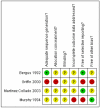Screening and subsequent management for gestational diabetes for improving maternal and infant health
- PMID: 20614455
- PMCID: PMC4161118
- DOI: 10.1002/14651858.CD007222.pub2
Screening and subsequent management for gestational diabetes for improving maternal and infant health
Update in
-
Screening and subsequent management for gestational diabetes for improving maternal and infant health.Cochrane Database Syst Rev. 2014 Feb 11;(2):CD007222. doi: 10.1002/14651858.CD007222.pub3. Cochrane Database Syst Rev. 2014. Update in: Cochrane Database Syst Rev. 2017 Aug 03;8:CD007222. doi: 10.1002/14651858.CD007222.pub4. PMID: 24515533 Updated.
Abstract
Background: Gestational diabetes mellitus (GDM) is a form of diabetes that occurs in pregnancy. Although GDM usually resolves following birth, it is associated with significant morbidities for mother and baby both perinatally and in the long term. There is strong evidence to support treatment for GDM. However, there is little consensus on whether or not screening for GDM will improve maternal and infant health and if so, the most appropriate protocol to follow.
Objectives: To assess the effects of different methods of screening for gestational diabetes mellitus and maternal and infant outcomes.
Search strategy: We searched the Cochrane Pregnancy and Childbirth Group's Trials Register (April 2010).
Selection criteria: Randomised and quasi-randomised trials evaluating the effects of different methods of screening for gestational diabetes mellitus.
Data collection and analysis: Two review authors independently conducted data extraction and quality assessment. We resolved disagreements through discussion or through a third author.
Main results: We included four trials involving 3972 women were included in the review. One quasi-randomised trial compared risk factor screening with universal or routine screening by 50 g oral glucose challenge testing. Women in the universal screening group were more likely to be diagnosed with GDM (one trial, 3152 women, risk ratio (RR) 0.44 95% confidence interval (CI) 0.26 to 0.75). Infants of mothers in the risk factor screening group were born marginally earlier than infants of mothers in the routine screening group (one trial, 3152 women, mean difference -0.15 weeks, 95% CI -0.27 to -0.53).The remaining three trials evaluated different methods of administering a 50 g glucose load. Two small trials compared glucose monomer with glucose polymer testing, with one of these trials including a candy bar group. One trial compared a glucose solution with food. No differences in diagnosis of GDM were found between each comparison. Overall, women drinking the glucose monomer experienced fewer side effects from testing than women drinking the glucose polymer (two trials, 151 women, RR 2.80, 95% CI 1.10 to 7.13). However, we observed high heterogeneity between the trials for this result (I(2) = 61%).
Authors' conclusions: There was insufficient evidence to determine if screening for gestational diabetes, or what types of screening, can improve maternal and infant health outcomes.
Figures
References
References to studies included in this review
-
- Bergus GR, Murphy NJ. Screening for gestational diabetes mellitus: comparison of a glucose polymer and a glucose monomer test beverage. Journal of the American Board of Family Practice. 1992;5(3):241–7. - PubMed
-
- Griffin ME, Coffey M, Johnson H, Scanlon P, Foley M, Stronge J, et al. Universal vs. risk factor-based screening for gestational diabetes mellitus: detection rates, gestation at diagnosis and outcome. Diabetic Medicine. 2000;17:26–32. - PubMed
-
- Martinez Collado JH, Alvarado Gay FJ, Danel Beltran JA, Gonzalez Martinez E. Glucose screening test in pregnant women. A comparison between the traditional glucose load and diet [Tamiz de glucosa en emabarazadas. Comparacion de la carga tradicional contra la dieta] Medicina Interna de Mexico. 2003;19(5):286–8.
-
- Murphy NJ, Meyer BA, Hogard ME. Carbohydrate sources for gestational diabetes screening. A comparison. Journal of Reproductive Medicine. 1994;39:977–81. - PubMed
References to studies excluded from this review
-
- Berkus MD, Langer O. Glucose tolerance test periodicity: the effect of glucose loading. Obstetrics & Gynecology. 1995;85:423–7. - PubMed
-
- Brustman LE, Gela BD, Moore M, Reilly KD, Langer O. Variations in oral glucose tolerance tests: the 100- versus 75-g controversy. Journal of the Association for Academic Minority Physicians. 1995;6(2):70–2. - PubMed
-
- Buhling KJ, Elsner E, Wolf C, Harder T, Engel B, Wascher C, et al. No influence of high- and low-carbohydrate diet on the oral glucose tolerance test in pregnancy. Clinical Biochemistry. 2004;37(4):323–7. - PubMed
-
- Cheng LC, Salmon YM, Chen C. A double-blind, randomised, cross-over study comparing the 50g OGTT and the 75g OGTT for pregnant women in the third trimester. Annals of the Academy of Medicine, Singapore. 1992;21(6):769–72. - PubMed
-
- Court DJ, Stone PR, Killip M. Comparison of glucose and a glucose polymer for testing oral carbohydrate tolerance in pregnancy. Obstetrics & Gynecology. 1984;64(2):251–5. - PubMed
References to studies awaiting assessment
-
- Bebbington MW, Milner R, Wilson RD, Harris S. A randomized controlled trial comparing routine screening vs selected screening for gestational diabetes in low risk population. American Journal of Obstetrics and Gynecology. 1999;180(1 Pt 2):S36.
-
- Meltzer SJ. [accessed 2009];An RCT to evaluate incidence, cost and clinical outcomes using 75 vs 100g. screening methods for gestational diabetes. 2006 ClinicalTrials.gov http://clinicaltrials.gov/
-
- Meltzer SJ, Snyder J, Morin L, Nudi M, Karalis A. Prevalence of gestational diabetes mellitus (GDM) among 5489 multi-ethnic pregnant women in Montreal using a randomized trial of a 75 vs 100g glucose load. Diabetologia. 2005;48(Suppl 1):A23.
Additional references
-
- American College of Obstetricians and Gynecologists ACOG practice bulletin. Clinical management guidelines of gestational diabetes for obstetrician-gynecologists. Obstetrics & Gynecology. 2001;98(3):525–38. - PubMed
-
- American College of Obstetricians and Gynecologists Postpartum screening for abnormal glucose tolerance in women who had gestational diabetes mellitus. Obstetrics & Gynecology. 2009;113:1419–21. ACOG committee opinion No. 235. - PubMed
-
- American Diabetes Association Gestational diabetes. Diabetes Care. 2003;26:S103–S105. - PubMed
-
- American Diabetes Association Nutrition recommendations and interventions for diabetes: a position statement of the American Diabetes Association. Diabetes Care. 2007;30:S48–S65. - PubMed
Publication types
MeSH terms
LinkOut - more resources
Full Text Sources
Miscellaneous



